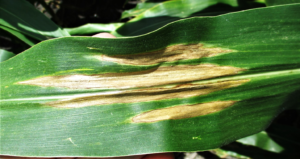As was the case in the spring of 2020, the fungal disease of corn, northern corn leaf blight (NCLB) (Figure 1), is again a concern in the spring of 2021. In most years in south and central Texas, a few lesions of the disease are seen on the lowest leaves and the disease never progresses. Disease development is driven by frequent rain and temperatures lower than 80°F. In a typical Texas growing season, infrequent rain, but moreover, increasing temperatures will hinder the progression of the disease. Cool, rainy weather in May, 2021 has the potential to support disease development. Although many fungicides are labeled for foliar application in corn, their use is not usually necessary or beneficial in south or central Texas. The main reason is that there are differences in susceptibility of hybrids and many of the hybrids planted in Texas have some degree of resistance to NCLB that make the use of fungicides unnecessary.
Another observation from 2020 was that there was a high prevalence of disease in corn cropped on land where the previous crop was corn, but there was low disease severity (i.e. the proportion of diseased leaf area was low). The pathogen carries over to the next season in crop residue. Crop rotation and residue management can play a major role in the presence and severity of NCLB in central and south Texas corn, and fields where the disease was extensively prevalent should be rotated out of corn the following year and crop residue should be plowed under, to hasten its decomposition.
Figure 1. Lesions of northern corn leaf blight, caused by the fungus, Exserohilum turcicum.
In the 2021 season, there are questions about the need to apply fungicides. Northern corn leaf blight has been such a minor disease in Texas that there have been no threshold studies to define a benefit of a fungicide application. In the Midwestern US, yield loss can occur if there is a substantial amount of disease at the time of silking. If high levels of disease is delayed until several weeks after silking, there is minimal disease loss. Until there is more data for Texas, the trigger for a fungicide application would be increasing disease development in a susceptible variety near or at silking, with a forecast of future rainy weather. A fungicide application would not be necessary for this disease later in the season.
In 2020, we did three ad hoc fungicide trials in central Texas corn fields that were showing early symptoms of NCLB. None of the trials showed a yield response to the fungicide application. The cessation of conducive weather was a factor, but probably the bigger factor was that the hybrids at all three locations had some degree of resistance to NCLB. Details of the trial, conducted with Tyler Mays (Extension Agent-IPM, Hill and McLennan Counties), John Few (Extension Program Specialist – IPM, Williamson County), and Zach Davis (Extension Agent-AG/NR, Hill County) are here (http://counties.agrilife.org/hill/files/2021/05/2020-Northern-Corn-Leaf-Blight-Fungicide-Trial.pdf ).
The following decision key provides points to consider in deciding whether a fungicide should be applied:
1. Does the hybrid have susceptibility to NCLB? E.g. on a scale of 1-10, where 10 is very susceptible, it ranks 8 or higher. Check the dealer or the company website for this information.
YES. Go to 2.
NO. No need to spray.
2. Was the previous crop corn and is there crop residue?
YES. Go to 3.
NO. No need to spray.
3. Are there lesions on at least 50% of the plants?
YES. Go to 4
NO. Don’t spray, but keep checking.
4. Is the corn approaching or at tassel?
YES. Go to 5.
NO. Don’t spray yet, but check the forecast for wet weather.
5. Is there rain in the forecast during the period that the corn will be at VT to R1?
YES. A preventative application of a fungicide would be warranted between VT and R1 (flowering).
NO. Don’t spray yet, but once the crop is past R1, there would not be a benefit from spraying a fungicide.
Note that this decision key is subject to revision as we get more data on damage thresholds affecting yield under Texas conditions.
For more information on corn management, including corn pest management, see the Hill County website (https://hill.agrilife.org/corn-resources/ ).
Thomas Isakeit, Professor and extension plant pathologist
Texas A&M AgriLife Extension Service, College Station
t-isakeit@tamu.edu; cell 979-229-4976
Tyler Mays, M.S., Extension Agent-IPM, Hill and McLennan Counties
Tyler.Mays@ag.tamu.edu Office: (254) 582-4022; Mobile: (979) 482-0111
